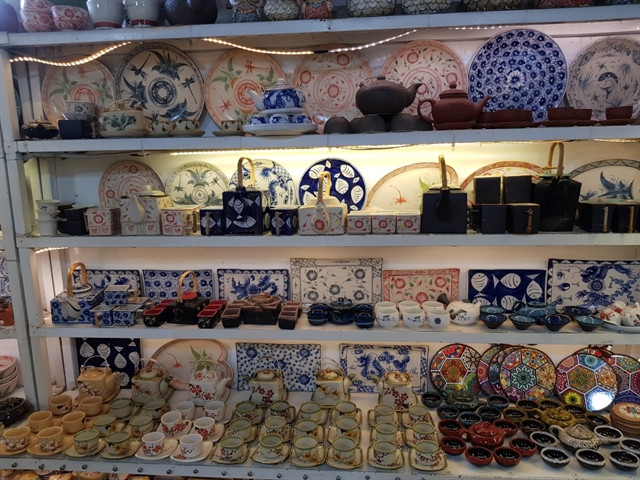In a world dominated by mass production, hand-made ceramics stand out as a unique blend of intricate design and meticulous craftsmanship. One community in Việt Nam is keeping that vital tradition alive.
"I'm really amazed by how hand-made ceramics here can thrive in such a mass-produced modern world," said tourist Oliver Brandon.
"They are a perfect blend of art and craft."
Brandon has been in Việt Nam for more than three years, taking photos of different pieces of craftsmanship in every corner of the country. He has explored the finer points of everything from knifemaking in Vĩnh Phúc to woodworking in Bắc Ninh, "but how they make things from clay in this town is something very unique, very different."
The town that Bradon was talking about is Thanh Hà, nestled along the lower reaches of the Thu Bồn River and boasting a five-hundred-year history of ceramic-making.
 |
| A view of Thanh Hà from above. The town has a ceramic-making tradition that spans over 500 years. — VNA/VNS Photos Lê Việt Dũng |
According to its elderly residents, the ancestors of eight family clans immigrated to Quảng Nam Province and founded the town in the 16th century. They built their first pottery kilns in Thanh Chiếm hamlet, a site close to the river for the ease of clay mining, and began to make ceramics for a living.
Their business had its heyday between the 19th and 20th centuries thanks to the boom of traders with wooden barges, who transported their ceramic products to distant marketplaces for a wider range of buyers. At its peak in the mid-20th century, the town accommodated hundreds of potters with more than 40 pottery wheels turning day and night.
The rise of plastics in the late 20th century, however, gradually eroded ceramics' prominence and put the potters in a tight spot. Many chose the easy way out by cutting back on ceramics and switching to bricks and tiles to stay in business. Others tried new ways of shaping clay to attract more customers.
And con thổi, ceramic instruments of animal shape that make sound when blowing air into their holes, were invented for that very reason. The zoomorphic playthings have become so popular that at least 37 families in the town keep crafting con thổi up until now.
"They are not just making functional things. They are making things that are functional and beautiful," said Brandon.
 |
| A family making con thổi. These ceramic whistles make a low and hollow sound when blown gently. — |
The traditional ceramic-making process is long and laborious, yet the one that young potter Trần Thị Tuyết Nhung, 25, has dedicated years of her life to learning and preserving. Her family holds on firmly to the art of handcrafting as they believe a human touch makes every creation characterful and unique.
"Each piece is individually hand-made and one of its kind. No two pieces are exactly alike," said Nhung.
The first step in making ceramics is clay preparation. In the past, potters mined their earthy material from local sources in Thanh Chiếm hamlet and several nearby sites. Those sites were abundant in yellow clay - a sticky material that is a top choice for pottery. Now they buy the clay from suppliers, who transport it to the town on their barges.
Once potters get the clay, they will wedge it to make sure it is homogenous and free of air bubbles. This step is particularly important as the presence of air pockets in the clay could result in cracks and holes in projects when they are exposed to the extreme heat of a kiln.
After the clay is properly wedged, a potter called thợ chuốt will form it into projects on a pottery wheel with the help of another potter called thợ đẩy, whose job is turning the wheel simultaneously. When the projects are formed, they will be left in the sun to dry.
 |
| Nhung, as a thợ đẩy, turning the pottery wheel by her foot while her mother was forming the clay ball into a pot. |
Upon the projects reaching the stage of partial dryness, referred to as leather-hard, another potter called thợ nhắm phơ will examine and refine them. There is little room for errors in this step because once the clay has dried beyond this point, no further shape change can be made.
 |
| Potters place completely dried pots next to a kiln. |
When the projects have dried completely, potters will apply the glaze to them and load them into a kiln for baking. The projects then undergo the extreme heat of the kiln until a translucent smoke billows out of its vent, indicating that the step has finished. The well-baked pieces of pottery can now be taken out of the kiln and ready to be used.
"It takes more than 24 hours to bake glaze-coated products in wood-fueled kilns, whereas around 16 hours in electric kilns," said Nhung.
Superior craftsmanship combined with a traditional technique passed down through generations has made a name for Thanh Hà's ceramics as products of elegant styles and wonderful functionalities. It is said that its vases can extend flowers' freshness for up to one week and its pots can make foods taste much better.
 |
| Ceramic products made by Nhung's family. |
After the COVID-19 pandemic, tourists began to flock to the town in large numbers to see local potters in action and get some of their exquisite pieces of pottery. All the revenues from ticket sales have been set aside for revamping the town and supporting the potters.
"I've got some ceramic whistles for my kids and a beautiful vase for my wife," said Brandon. — VNS